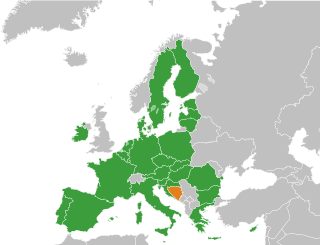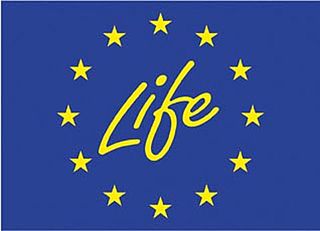
The European Investment Bank (EIB) is the European Union's investment bank and is owned by the 27 member states. It is the largest multilateral financial institution in the world. The EIB finances and invests both through equity and debt solutions companies and projects that achieve the policy aims of the European Union through loans, equity and guarantees.

The European Union (EU) has expanded a number of times throughout its history by way of the accession of new member states to the Union. To join the EU, a state needs to fulfil economic and political conditions called the Copenhagen criteria, which require a stable democratic government that respects the rule of law, and its corresponding freedoms and institutions. According to the Maastricht Treaty, each current member state and the European Parliament must agree to any enlargement. The process of enlargement is sometimes referred to as European integration. This term is also used to refer to the intensification of co-operation between EU member states as national governments allow for the gradual harmonisation of national laws.
The European Union has a number of relationships with foreign states. According to the European Union's official site, and a statement by Commissioner Günter Verheugen, the aim is to have a ring of countries, sharing EU's democratic ideals and joining them in further integration without necessarily becoming full member states.

The regional policy of the European Union (EU), also referred as Cohesion Policy, is a policy with the stated aim of improving the economic well-being of regions in the European Union and also to avoid regional disparities. More than one third of the EU's budget is devoted to this policy, which aims to remove economic, social and territorial disparities across the EU, restructure declining industrial areas and diversify rural areas which have declining agriculture. In doing so, EU regional policy is geared towards making regions more competitive, fostering economic growth and creating new jobs. The policy also has a role to play in wider challenges for the future, including climate change, energy supply and globalisation.

The European Structural and Investment Funds are financial tools governed by a common rulebook, set up to implement the regional policy of the European Union, as well as the structural policy pillars of the Common Agricultural Policy and the Common Fisheries Policy. They aim to reduce regional disparities in income, wealth and opportunities. Europe's poorer regions receive most of the support, but all European regions are eligible for funding under the policy's various funds and programmes. The current framework is set for a period of seven years, from 2021 to 2027.
The Phare programme is one of the three pre-accession instruments financed by the European Union to assist the applicant countries of Central and Eastern Europe in their preparations for joining the European Union.
SAPARD (Special Accession Programme for Agriculture and Rural Development) was a financial assistance program established in June 1999 by the Council of the European Union to help countries of Central and Eastern Europe deal with the problems of the structural adjustment in their agricultural sectors and rural areas, as well as in the implementation of the acquis communautaire concerning the Common Agricultural Policy (CAP) and related legislation.
The CARDS programme, of Community Assistance for Reconstruction, Development and Stabilisation, is the EU's main instrument of financial assistance to the Western Balkans, covering specifically the countries of Croatia, Bosnia and Herzegovina, Serbia, Montenegro, North Macedonia, Kosovo and Albania. It was created in 2000 by Council Regulation 2666/2000. However it was only in 2001 that the programme became operative under its own regulations, as in the first period it supported projects previously funded by the PHARE and OBNOVA programmes. The programme is the main financial instrument of EU's Stabilisation and Association process (SAp). A total of €5.13 billion is secured for all CARDS actions during 2000-2006, as after that day it will be replaced by the Instrument for Pre-Accession Assistance (IPA), which will cover both candidate and potential candidate countries.
Interreg is a series of programmes to stimulate cooperation between regions in and out of the European Union (EU), funded by the European Regional Development Fund. The first Interreg started in 1989. Interreg IV covered the period 2007–2013. Interreg V (2014–2020) covers all 27 EU member states, the EFTA countries, six accession countries and 18 neighbouring countries. It has a budget of EUR 10.1 billion, which represents 2.8% of the total of the European Cohesion Policy budget. Since the non EU countries don't pay EU membership fee, they contribute directly to Interreg, not through ERDF.

Albania is on the current agenda for future enlargement of the European Union (EU). It applied for EU membership on 28 April 2009, and has since June 2014 been an official candidate for accession. The Council of the European Union decided in March 2020 to open accession negotiations with Albania.

The accession of Bosnia and Herzegovina to the European Union is the stated aim of the present relations between the two entities. Bosnia and Herzegovina has been recognised by the EU as a "candidate country" for accession since the decision of the European Council in 2022 and is on the current agenda for future enlargement of the EU. Bosnia and Herzegovina takes part in the Stabilisation and Association Process and trade relations are regulated by an Interim Agreement.
The Instrument for Pre-Accession Assistance, or simply IPA, is a funding mechanism of the European Union. As of 2007, it replaced previous programmes such as the PHARE, ISPA, SAPARD and CARDS. Unlike the previous assistance programs, IPA offers funds to both EU candidate countries and potential candidates.
European Union (EU) concepts, acronyms, and jargon are a terminology set that has developed as a form of shorthand, to quickly express a (formal) EU process, an (informal) institutional working practice, or an EU body, function or decision, and which is commonly understood among EU officials or external people who regularly deal with EU institutions.
The European Union Solidarity Fund (EUSF) was founded in 2002. Its objective is to provide assistance to European Union member states when large-scale disasters occur. Catastrophes are considered to be large-scale if the estimated direct cost of damage exceeds 3 billion euro or 0.6% of gross national income of the country concerned. Since its inception, the Fund has provided assistance to member states as a result of 56 disasters including earthquakes, forest fires, drought, storms and floods. According to a European Commission report, Italy and Germany have been the leading beneficiaries of these emergency funds, though in total 23 states have received support.

On 1 January 2007, Bulgaria and Romania became member states of the European Union (EU) in the fifth wave of EU enlargement.

The LIFE programme is the European Union's funding instrument for the environment and climate action. The general objective of LIFE is to contribute to the implementation, updating and development of EU environmental and climate policy and legislation by co-financing projects with European added value. LIFE began in 1992 and to date there have been five phases of the programme. During this period, LIFE has co-financed some 4600 projects across the EU, with a total contribution of approximately 6.5 billion Euros to the protection of the environment and of climate. For the next phase of the programme (2021–2027) the European Commission proposed to raise the budget to 5.45 billion Euro.

Cross-border cooperation is the collaboration between adjacent areas across borders. In the European Union this is one of the forms of territorial cooperation. The European model is very diverse with cooperation between border regions or municipalities, or through specific cooperation structures. These structures are usually composed by public authorities from different countries organized in working communities, euroregions or EGTCs.
The Cohesion Fund (CF), one of the five European Structural and Investment Funds of the European Union, provides support to Member States with a gross national income (GNI) per capita below 90% EU-27 average to strengthen the economic, social and territorial cohesion of the EU. Common regulatory provisions apply to the five ESIF funds, along with the Just Transition Fund, the Asylum, Migration and Integration Fund, the Internal Security Fund and the Instrument for Financial Support for Border Management and Visa Policy.

Since its accession in the European Union in 2007, Bulgaria has been part of the EU's Cohesion Policy. This program introduces financial instruments, also known as the European Structural and Investment Funds, which aim to reduce the gap between different regions of the EU and improve their economic wellbeing.









